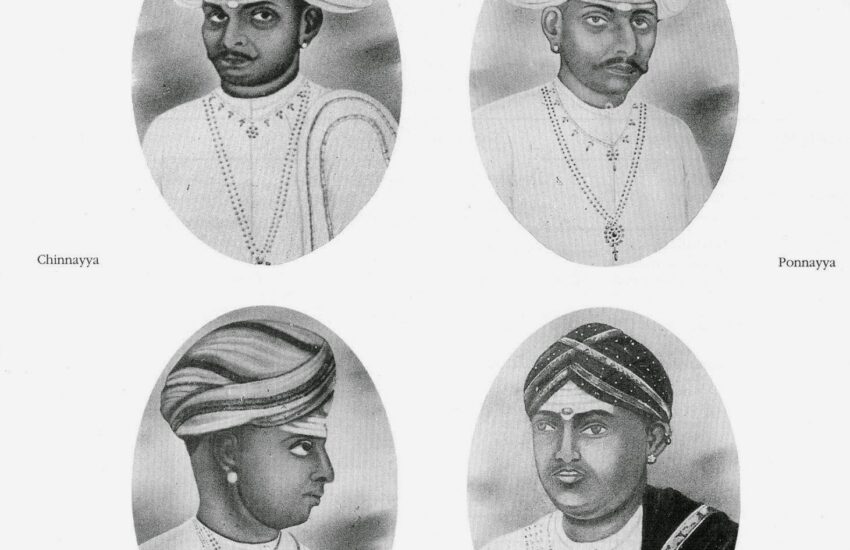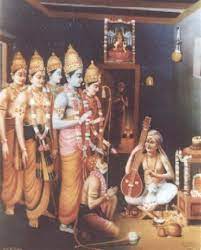Tiruppamburam Swaminatha Pillai
Tiruppamburam Swaminatha Pillai – Ravi & Sridhar
The Isai Vellala community has been responsible for nurturing music and dance in the Tamil country for many centuries. Every male member of that community was required to learn the Nagaswaram and every female member, chinna mELam or sadir — Bharatanatyam as it is called now. They were attached to the temples and received grants from kings for furthering their art. Music and dance were part of the daily services in temples and the Isai Vellala community fulfilled their obligations towards the Lord admirably. In the process there sprang many artistes who were not just satisfied with doing their duty by the Lord but who pursued aesthetic beauty in art and raised not only themselves above the mundane but rasikas and the art itself
Broadmindedness and catholicity are at a premium even in these times when the world has become really small. In the art world, jealousy and secretiveness were quite common in those days. The caste system forbade the purists from sharing their art with the so-called lesser born. In such a milieu Muthuswami Dikshitar’s liberality was a fresh approach that played no small role in the renaissance of music. The great composer’s all-embracing nature was matched only by his own great stature as a composer. His catholicity was such that most of his disciples belonged to the Isai Vellala community and some even from the Parasaiva community. Shuddha Maddhalam Tambiyappan, the artist attached to the Tiruvarur Thyagaraja temple was a senior disciple of Muthuswami Dikshitar. Devadasis like Kamalam, Natyacharyas like the Tanjore Quartette and Nagaswara vidwans attached to various temples in Tanjavur district were all beneficiaries of Dikshitar’s munificence. Amidst these then great artists, there were a couple of disciples who belonged to the brahmin community too. One of them was Sathanur Panchanada Iyer. He was the junior most disciple of Muthuswami Dikshitar and started learning from the great composer during his last years. After Dikshitar’s vidEha mukti, Panchanada Iyer continued his music education under Shuddha Maddhalam Tambiyappan. Many junior disciples kept the Dikshitar flame alive by honing their skills and perfecting their Dikshitar repertoire through tutelage under senior disciples like Tambiyappan.
Panchanada Iyer has been referred to by the Tamil scholar U.V. Swaminatha Iyer as being one of the important musicians of the Tanjavur area during the 19th century. Panchanada Iyer is now remembered by the music world for his unique contribution in siring two disciples who in turn, spawned a whole new world where Dikshitar kritis occupied the pride of place and were noted for their authentic versions. Veena Dhanammal and Tiruppamburam Natarajasundaram Pillai, the Nagaswaram maestro were the two prime disciples of Sattanur Ayya, as Veena Dhanammal fondly referred to him. The violin maestro Tirukkodikaval Krishna Iyer was another disciple of Panchanada Iyer. Dhanammal used to refer to Sattanur Panchanada Iyer’s rAga bhAvam and used to say that she had never heard such rAga bhAvam from anyone else. How could it not be so, when even at a very impressionable age, Sattanur Ayya had the opportunity of sitting at the Maha Purusha’s feet and imbibing his classics directly from him? No wonder that both Dhanammal and Natarajasundaram Pillai considered Sattanur Panju Iyer as their most important guru. Once, after many years Natarajasundaram Pillai came to visit Dhanammal and suggested that they should sing together a few Dikshitar kritis that they had learnt from their Ayya. Both sang and found, that after all those years there was not a whit of difference in their versions. Both had retained the music to the minutest sangati. The pristine purity of the strong, solid legacy that Dikshitar had left to Sattanur Ayya was maintained in letter and in spirit by these veterans and also passed on to the succeeding generations.
Natarajasundaram Pillai was born in 1869 to Swaminathan who was basically a vocalist, though his ancestors were Nagaswaram vidvans. This family originally belonged to Mayavaram but Swaminathan shifted to Tiruppamburam, also in Tanjavur district, because many of his patrons were based in that village and nearby areas. Natarajasundaram Pillai and his brother Subramania Pillai were the first Nagaswara vidwans to play as a duo. Natarajasundaram Pillai published a book of Dikshitar kritis called dikShita kIrtanai prakAshikai.
Natarajasundaram Pillai had three sons of whom Swaminatha Pillai, who was born in 1898, was the eldest. All three sons were trained by their father to be Nagaswara vidwans. Swaminatha Pillai, after a few years of training on the Nagaswaram switched over to vocal music. After his voice broke, Swaminatha Pillai switched to the flute. He taught himself the fingering and embouchure (mouthing techniques) of the flute. His aim was to make the flute play gamakAs like the voice and in this too he had none to teach him. He therefore learnt it himself and succeeded to a great extent.
Swaminatha Pillai did not strike a different path as far as the spirit of the music itself was concerned. Swaminatha Pillai inherited his love for Dikshitar kritis from his father and achieved excellence in them. In those days Palladam Sanjeeva Rao was the most popular flautist. Later Mali was the reigning monarch of the instrument. In spite of this Tiruppamburam Swaminatha Pillai was much respected and admired. Mali himself has spoken very highly of Swaminatha Pillai and his style. Swaminatha Pillai mainly followed the Dikshitar style of viLambakAlA and gamakAs and succeeded in approximating his flute artistry to singing, thus bringing about a wholesome and refreshing approach to music itself.
waminatha Pillai played a lot of Dikshitar kritis in his concerts. The chaturdasha rAgamAlikA, srI vishvanAtham was introduced to the concert stage and popularised by him. The navarOj kriti hastivadanAya namasthubyam was also popularised by him. He also patiently studied the 108 rAga-tALAmAlikA of Ramaswami Dikshitar and taught it to deserving students. Such was his passion for rare, challenging works.
Swaminatha Pillai taught at the Central College of Music, Madras. There, during his tenure, he taught a number of Dikshitar kritis to students as well as to other teachers, thus helping in wide dissemination of the composer’s soulful works. Swaminatha Pillai also taught for sometime at the Annamalai University’s music department. He also taught a few earnest students in the gurukulA method. T. Viswanathan, a grandson of Dhanammal learnt the flute from him. T.V. Namaivayam, S. Narasimhalu and Sirgazhi Govindarajan learnt vocal music from Swaminatha Pillai.
Swaminatha Paillai passed away in February 1961. He will be remembered for having nurtured the legacy of Muthuswami Dikshitar and for bringing to light rare compositions of the great composer.

